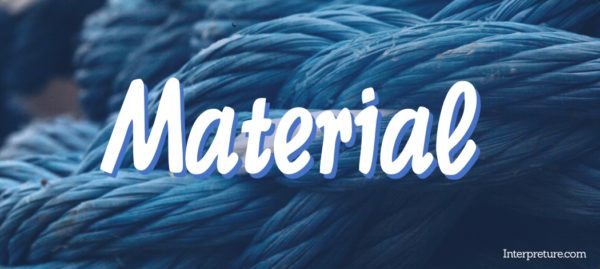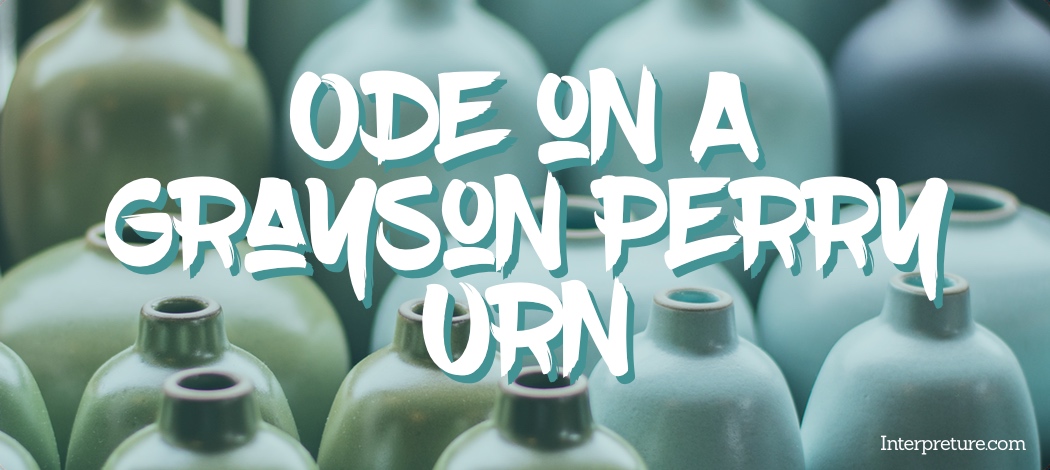‘Material’ is a poem by Ros Barber which considers the transition between childhood and adulthood, and the narrator’s nostalgia for a less consumer-driven world through the description of a traditional handkerchief. Barber was born in America but raised in England, and is an internationally renowned scholar of Christopher Marlowe who some believe, including Barber, to be the true writer of Shakespeare’s work. Interestingly, a handkerchief features prominently in both ‘Othello’ and this poem. The collection ‘Material’ and the poem itself were her response to the death of her mother in 2002, with further background information available on Barber’s website.
This poem is part of the set of prescribed poems that could be included in the Edexcel English Literature exam, meaning that it is important to study, understand and revise this poem. This poem was a named poem in the 2018 AS Level Exam. Click here to see all the prescribed poems from the ‘Poems of the Decade’ collection.

Interpreture gives ‘Material’ a difficulty rating of 2, meaning that it is deemed to be relatively straightforward. The meaning is very clear to the majority of readers and students through the accessible language used, which in turn mean that themes can be easily identified. The most difficult aspect of the poem is the structure due to its overall consistency, however there are still good points that can be made with deeper analysis.
‘Material’
The title of the poem helps to immediately give a reader an indication of what the poem is about, although at the same time it remains relatively ambiguous due to the large amount of possibilities for what might be explored in reference to ‘Material’. It is also interesting to note how the title links directly to the end of the poem, helping to make the poem come together as one and act as a key reminder of the poem’s message. The four syllables of ‘Material’ also help to lengthen the title in speech but not in its presence on the page, which is interesting for a reader because it could be seem as symbolic of the deeper ideas presented in the poem.

Poem Structure
There are regular verses throughout the poem with the exception of the sixth stanza, which breaks from the typical eight line rule of the poem to have nine lines, and is also the only example of enjambment across stanzas. This slightly disrupts the flow of the poem, and therefore makes it more noticeable to a reader and marks the tonal shift of the poem, as from this point onwards it has the feeling of sadness-tinged nostalgia due to the changes in attitude which have occurred throughout society.
Each stanza (with the exception of the fifth) ends with an end-stopped line, which can be interpreted as representing the traditional structure of society and the world in times gone by, with the one break in this pattern representing a transition. In addition, all of the first lines of the three final stanzas are only one line, with the lengthened pause creating a tone of consideration and reflection which is not as apparent earlier on in the poem.
Unlike many other poets from the ‘Poems of the Decade’ collection, Barber also makes use of the visual form of the poem with italic phrases to show names or phrases said by others, helping to add further emphasis to them. This is very effective for the final two lines of the poem, because it helps to act as a visual reference for a reader in order to remember the message of the poem more successfully, with the reference to “daughter” making the poem end on a very sentimental note. Another poem within the anthology which uses a similar technique is ‘A Minor Role’.
Poetic Techniques
One of the more obvious poetic devices used in ‘Material’ is the symbolism of the handkerchief. While it can be interpreted literally, it can also be understood to represent many ideas and features of a past time in the poet’s childhood with their mother. The use of symbolism means that readers can associate their own experiences and ideas with the poem, helping to make the technique and poem as a whole much more memorable and effective.
A sentimental tone is also established through the contraction of words, such as cardigan being shortened to “cardi” in the second stanza. This brings a more natural speech and rhythm to the poem, making it sound more story-like and therefore more personal. This has connotations of personalisation, family life and sentiment, once again helping to make useful long term possessions seem significant in comparison to a more materialistic world today. Similarly, there is heavy use of personal pronouns to further emphasise the personal connections and ideas.
Many references are very descriptive, with the imagery presented to a reader making them feel that they are almost that person and able to remember these occasions, which is very helpful in making a reader empathise with the narrator. This contributes significantly to Barber’s aim of showing how consumable the world has become, with this imagery being very helpful for those readers who may not have considered these ideas before.
Important Lines
“Nostalgia only makes me old.”
Being one of the shortest lines of the poem helps contrast this idea against the long, almost rambling sentences of the previous stanza in a relatively abrupt way. It makes a reader question why the narrator has been nostalgic up to this point, which in turn indicates that the narrator feels old in relation to the huge changes in societal attitudes since their childhood. Readers could also interpret that the narrator doesn’t want their children to grow up to a similar situation, as supported by the following lines in the seventh stanza.
“their soft and hidden history”
An object usually disregarded is given new significance in this line, with the alliteration of “hidden history” identifying the importance that an object so simple (and family heirlooms and possessions in general) have had over generations. Some readers may interpret this line as also alluding to the idea of tradition, noticing how the tradition and significance of many possessions such handkerchiefs have been diminished in recent years.
“tissues and uncertainty”
It becomes apparent in the final stanza of ‘Material’ that the ideas of consumerism that are present throughout the poem are just the surface level of emotions that the narrator has, shown through the sadness in relation to the death of their mother. Noting how she too no longer used handkerchiefs, the idea of “uncertainty” is discussed, and that the most important thing was to make the best of whatever situation pragmatically.
‘Material’ Key Themes
- Childhood: Throughout ‘Material’ there is strong consideration of childhood and childhood experiences, with the narrator looking at how situations have changed and developed over time and everything that has been lost in that time.
- Identity: Core principals of the mother and narrator are considered, with their actions and opinions being used to build up the identity presented to the reader. There is also the concept of societal identity which can be interpreted as being alluded to in the poem, and how different objects or customs can be very important even if their physical value is low.
- Past and Present: There is a clear transition of time in this poem, shown through the language and imagery as readers move from the nostalgic past to the more uncertain present, with considerations made for the future too. This would be quite noticeable to a reader because of the speed of the transition, in a similar way to ‘The Fox in the National Museum of Wales’.
Quick Focus Questions
- How does the structure of ‘Material’ contribute to a reader’s interpretation?
- What examples of contrasting imagery and ideas are there in the poem, and how are these effective?
- Would the title have been more memorable or have greater impact if it were different? Explain your reasoning.
The ideas behind ‘Material’ are certainly interesting and worthy of consideration, particularly through the use of structure which arguably adds a slightly more intricate and complex element to the poem. It can be slightly more challenging to pick out specific language devices that are suitable for comparison to other poems in the anthology due to an overall lack of them, which could make answering an essay question on this poem more difficult. For example, a comparison with ‘To My Nine-Year-Old Self’ may be more dependent on structural comparison than other poems such as ‘Effects’ or ‘On Her Blindness’ which feature easier points for both language and structure.







8 Comments
summary pls
summary please.
what does the handkerchief and tissues symbolise
The handkerchief is used to represent history and the past, using nostalgia to look back on how things used to be. It’s enduring and able to last a long time. In contrast, tissues are much less durable and are used to show how modern society consumes and discards rather than keeps – they’re specifically linked to “uncertainty” in the poem.
Think of the materials of each, tissues are thin easy to rip short lasting, thrown away with no significance, handkerchiefs are strong long lasting, reliable like their mother used to be. It represents childhood vs adulthood and how theyve changed as parents
loss of tradition to a more consumable world
This was great information, revising for poetry mocks, your website is my one stop shop :)
Keep creating amazing content!
Thank You for the insightful analysis as always! I had been struggling to compare this poem to other poems of the decade as I was conflicted by the multitude of themes (Childhood vs Adulthood, Motherhood, Identity, Past vs Future), but after considering your perspective and take on the poem above I definitely feel more confident delving into this poem. In particular, I really enjoyed your point on how the poem deliberately creates a more personal and empathetic connection with the reader so the reader can associate their own experiences with the poem – I had not considered that in such a way and now I can really appreciate the author’s art and techniques!